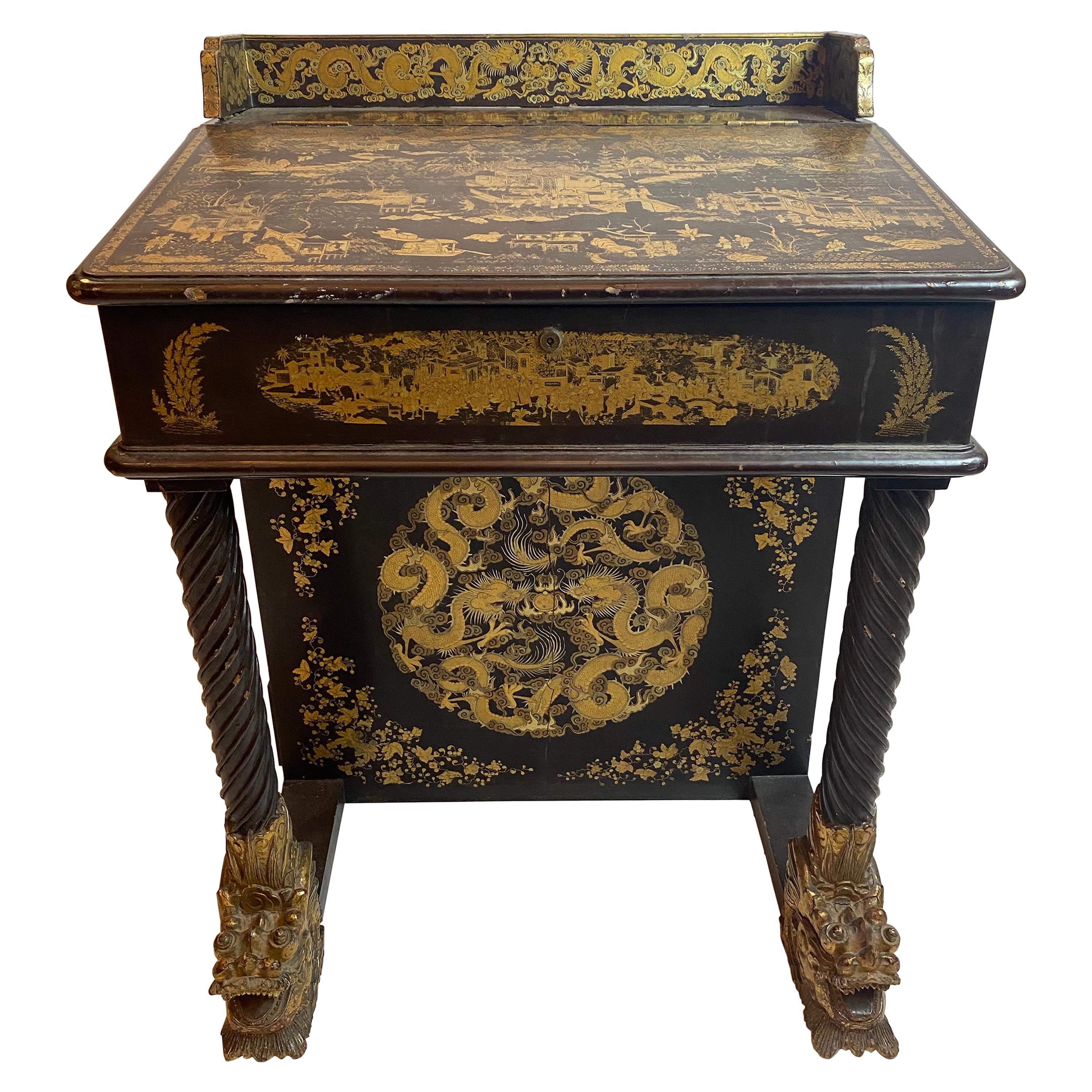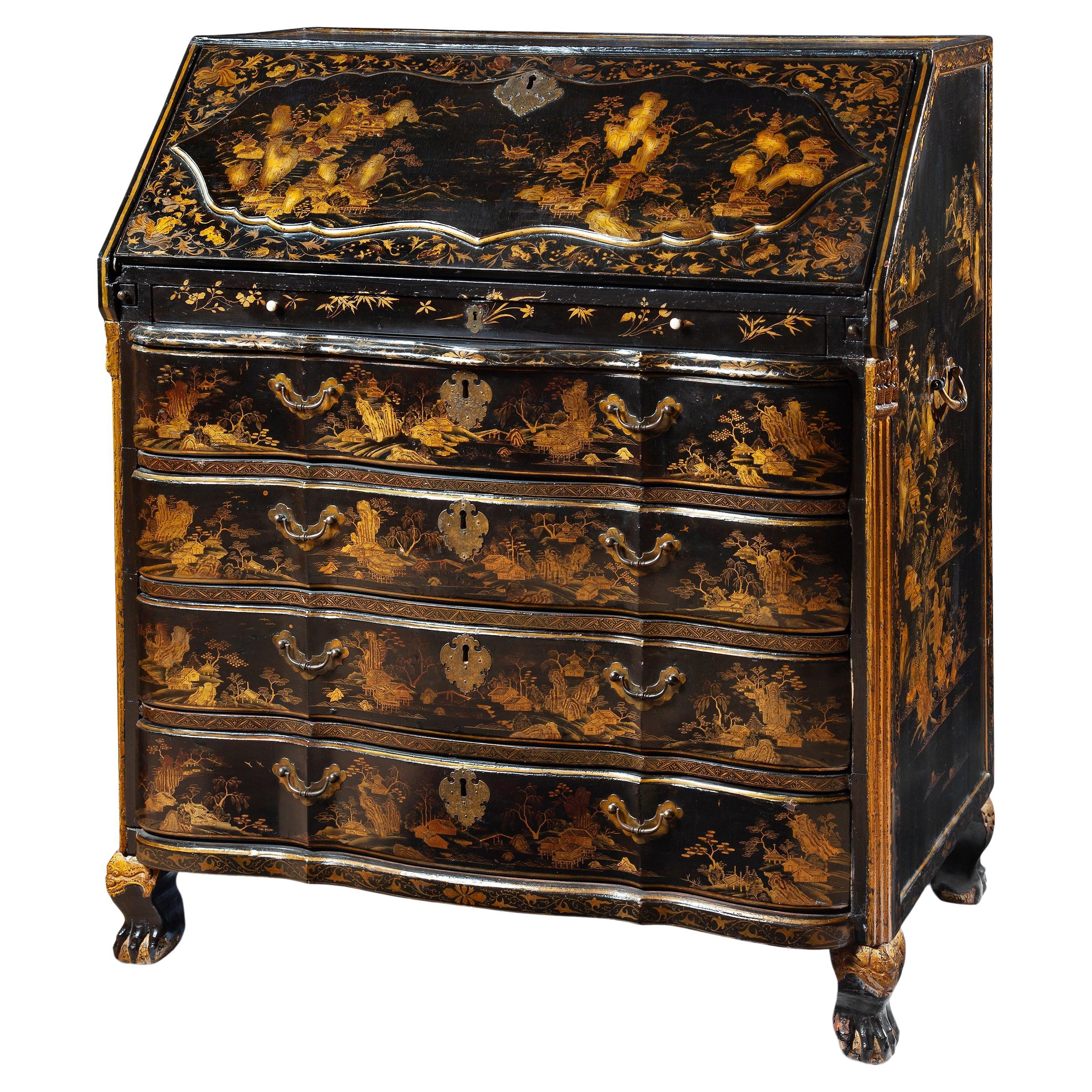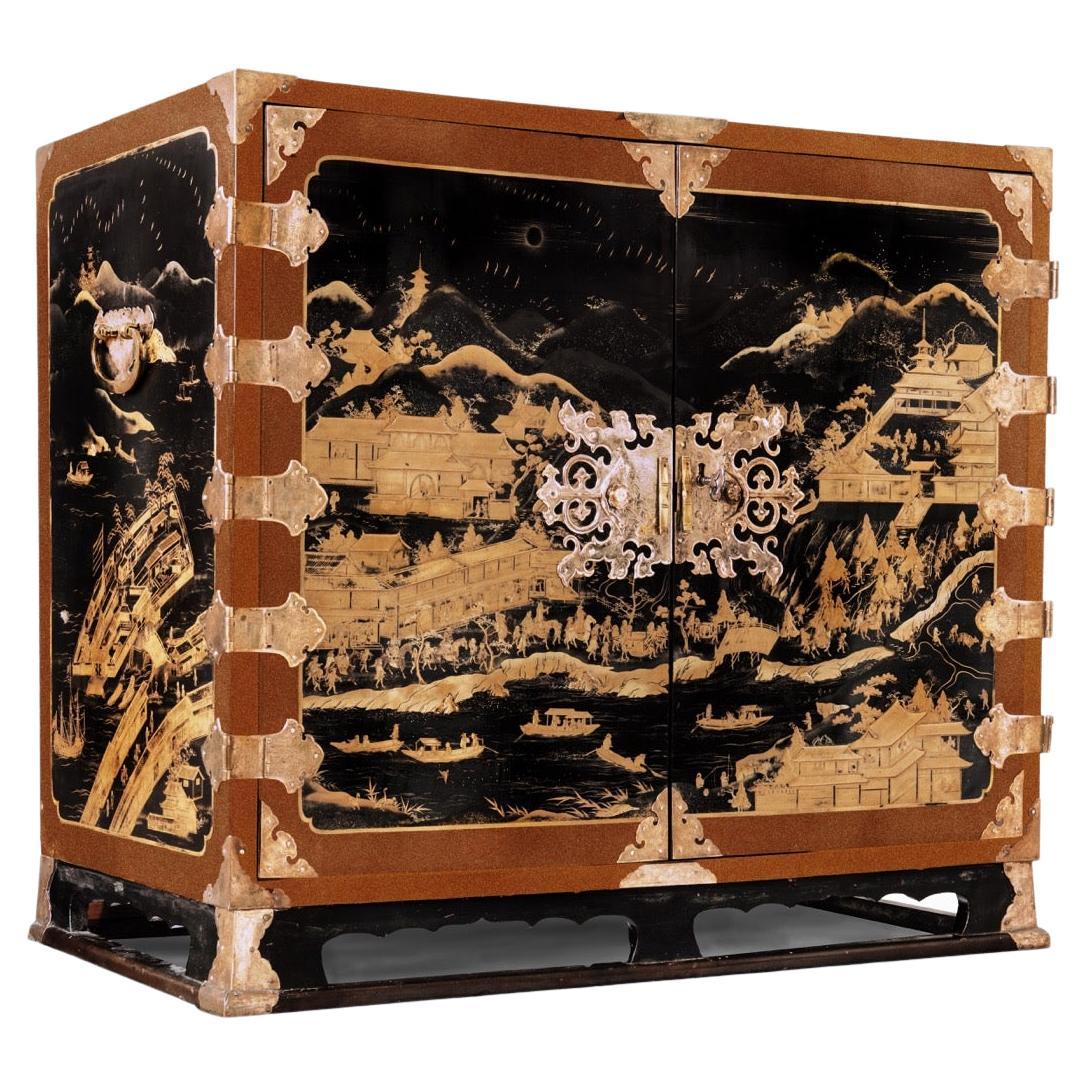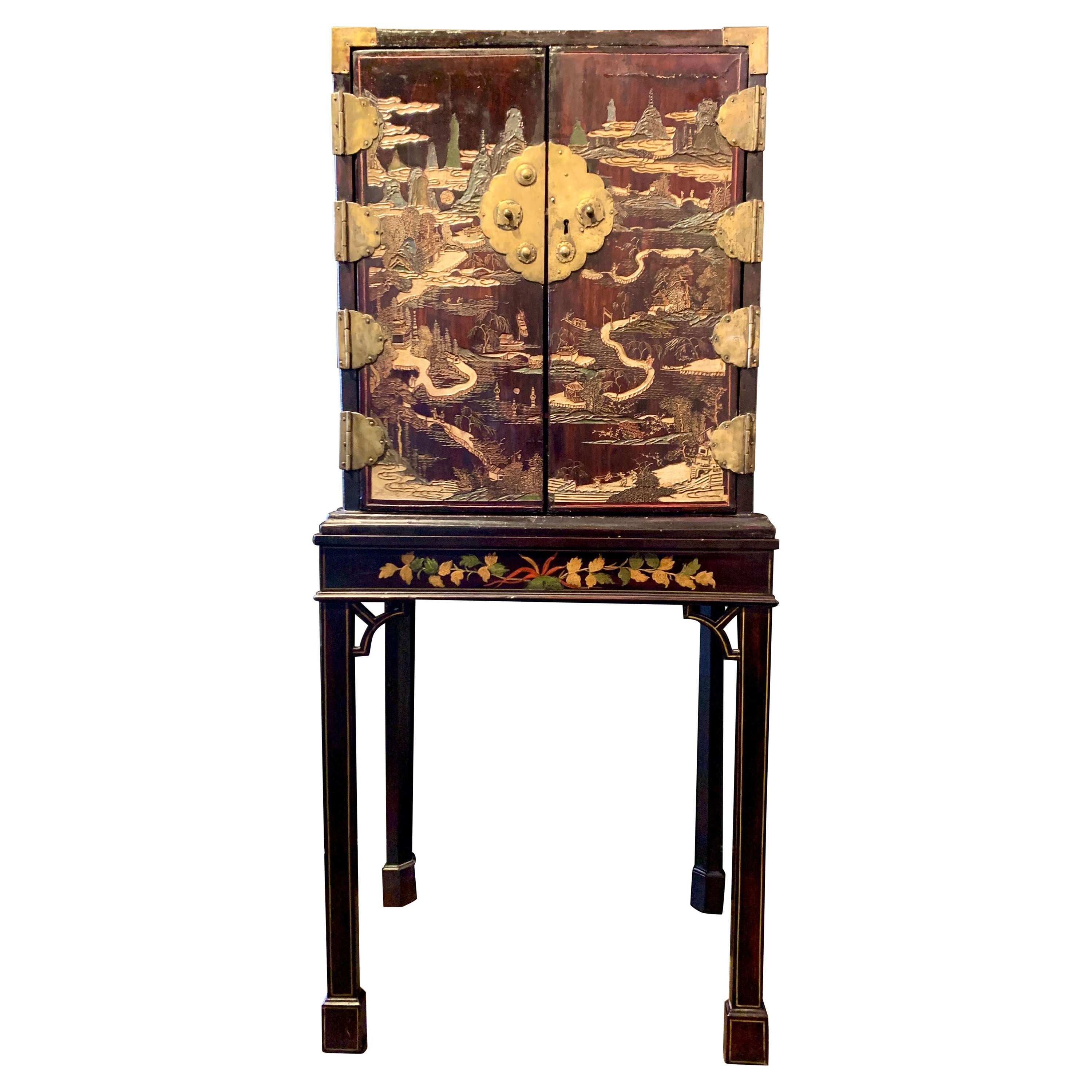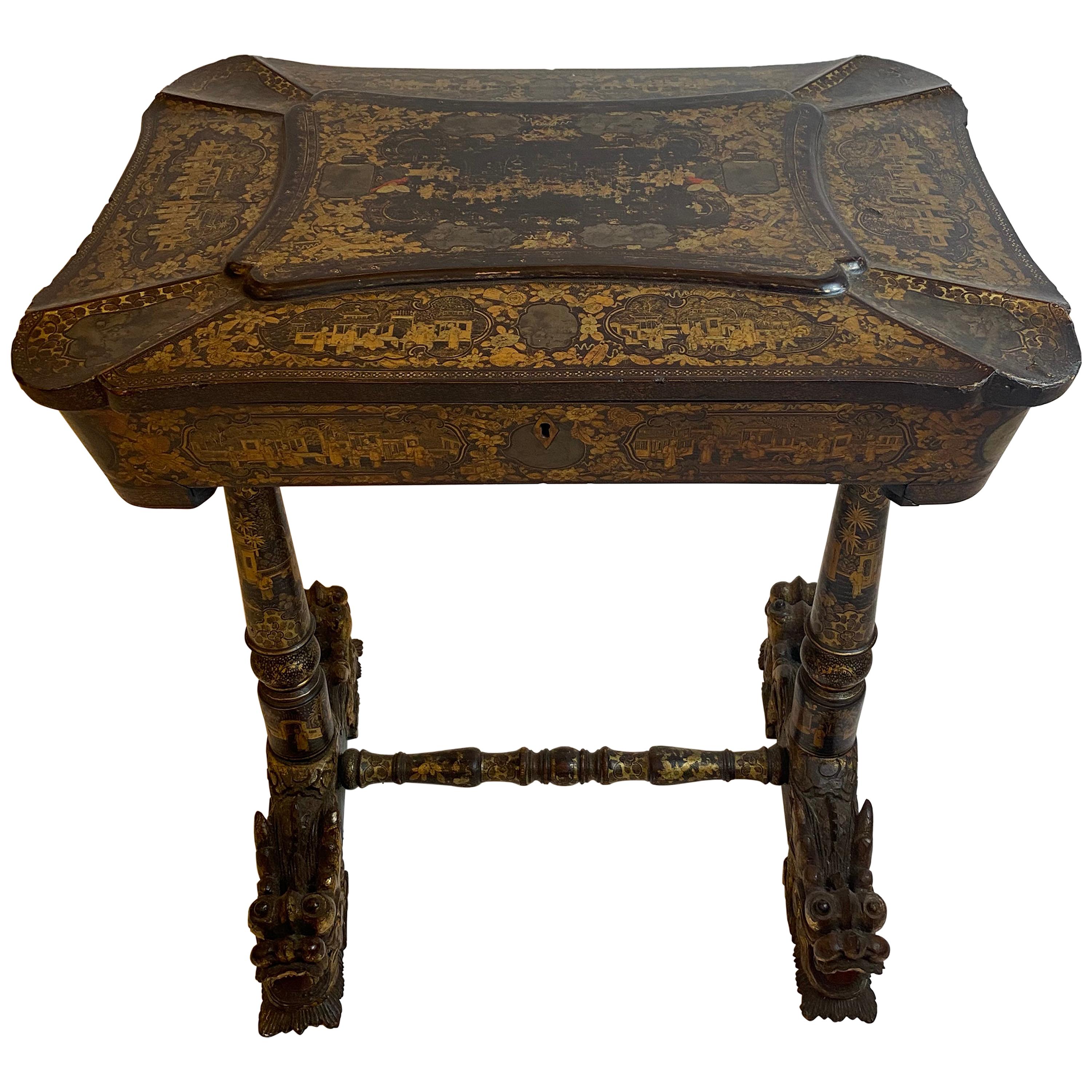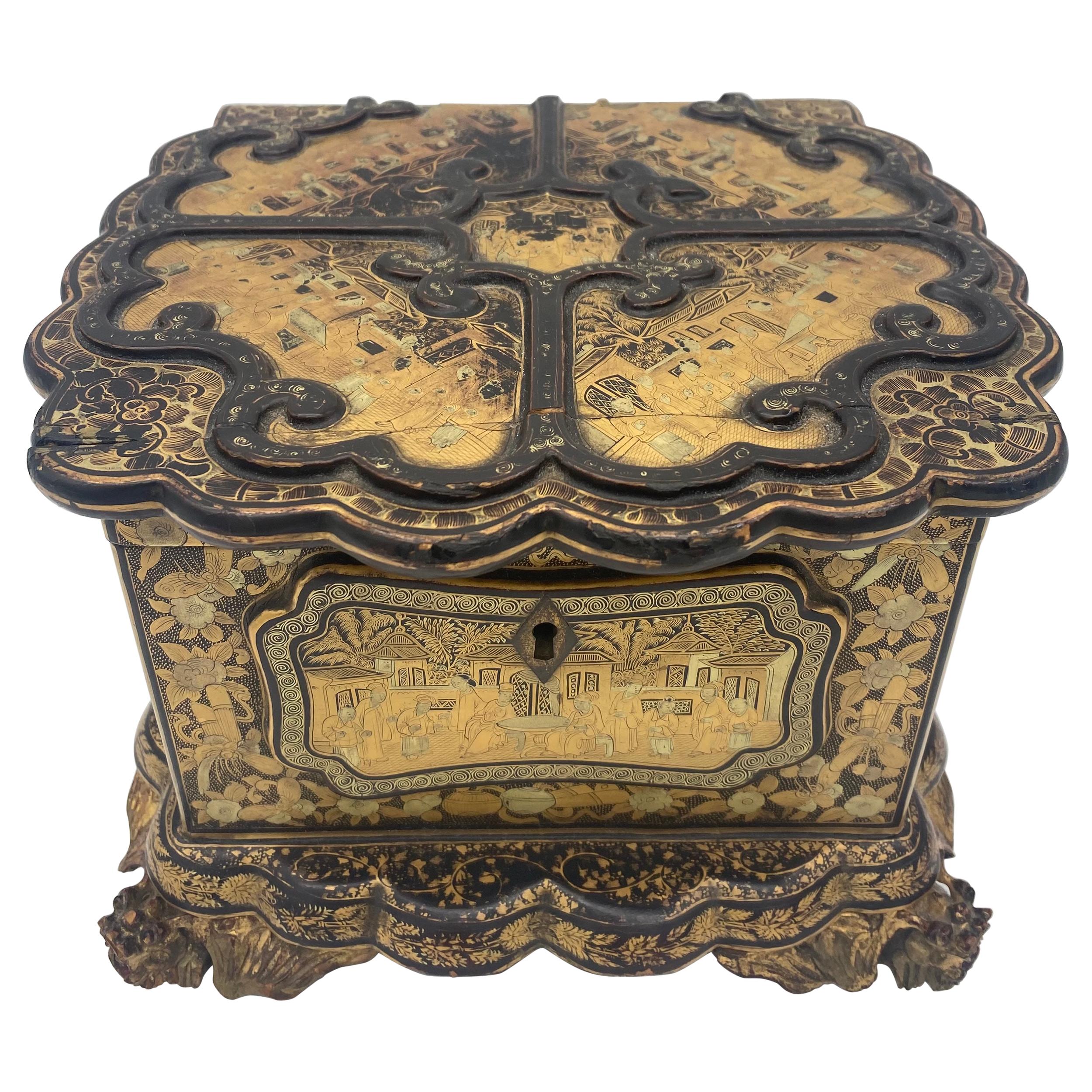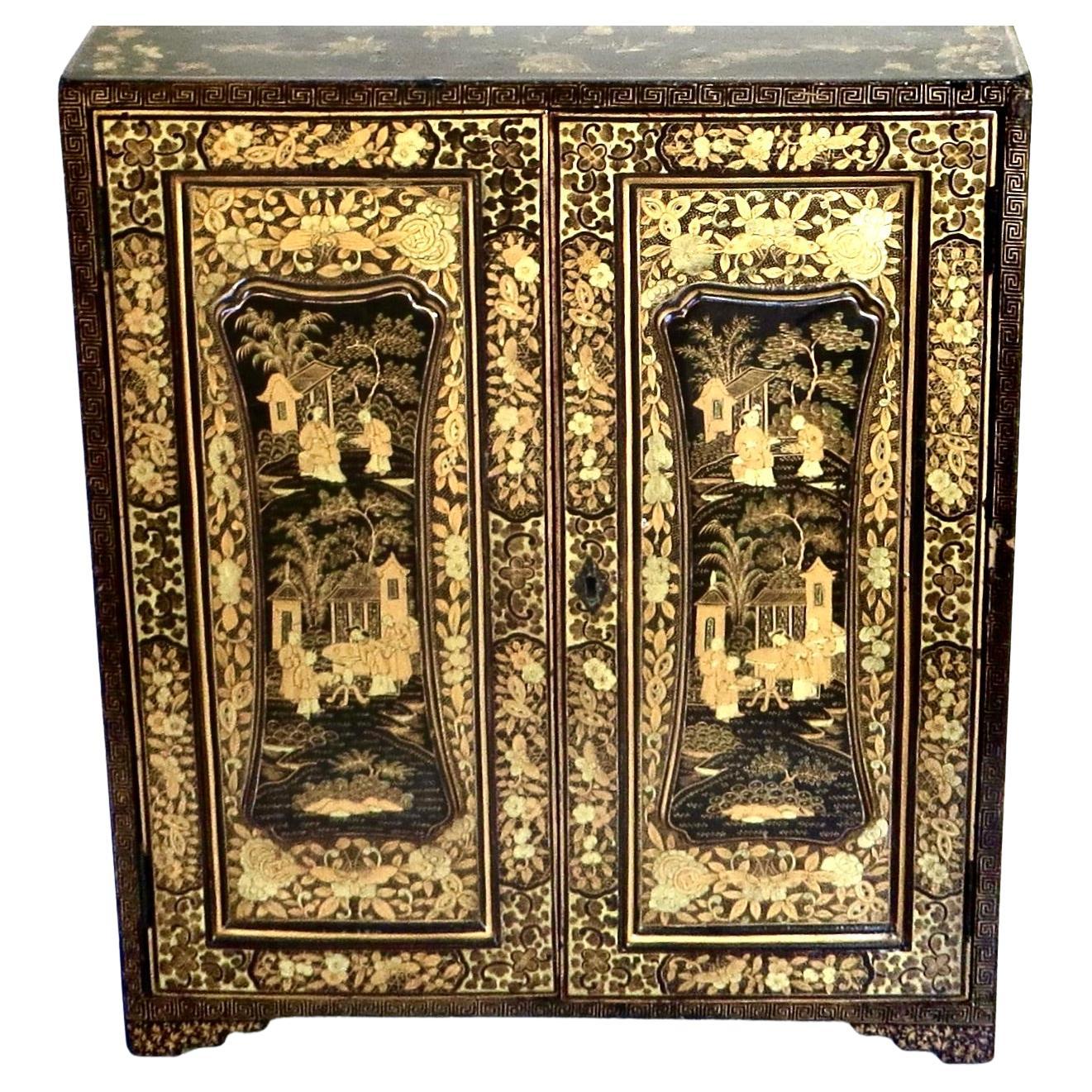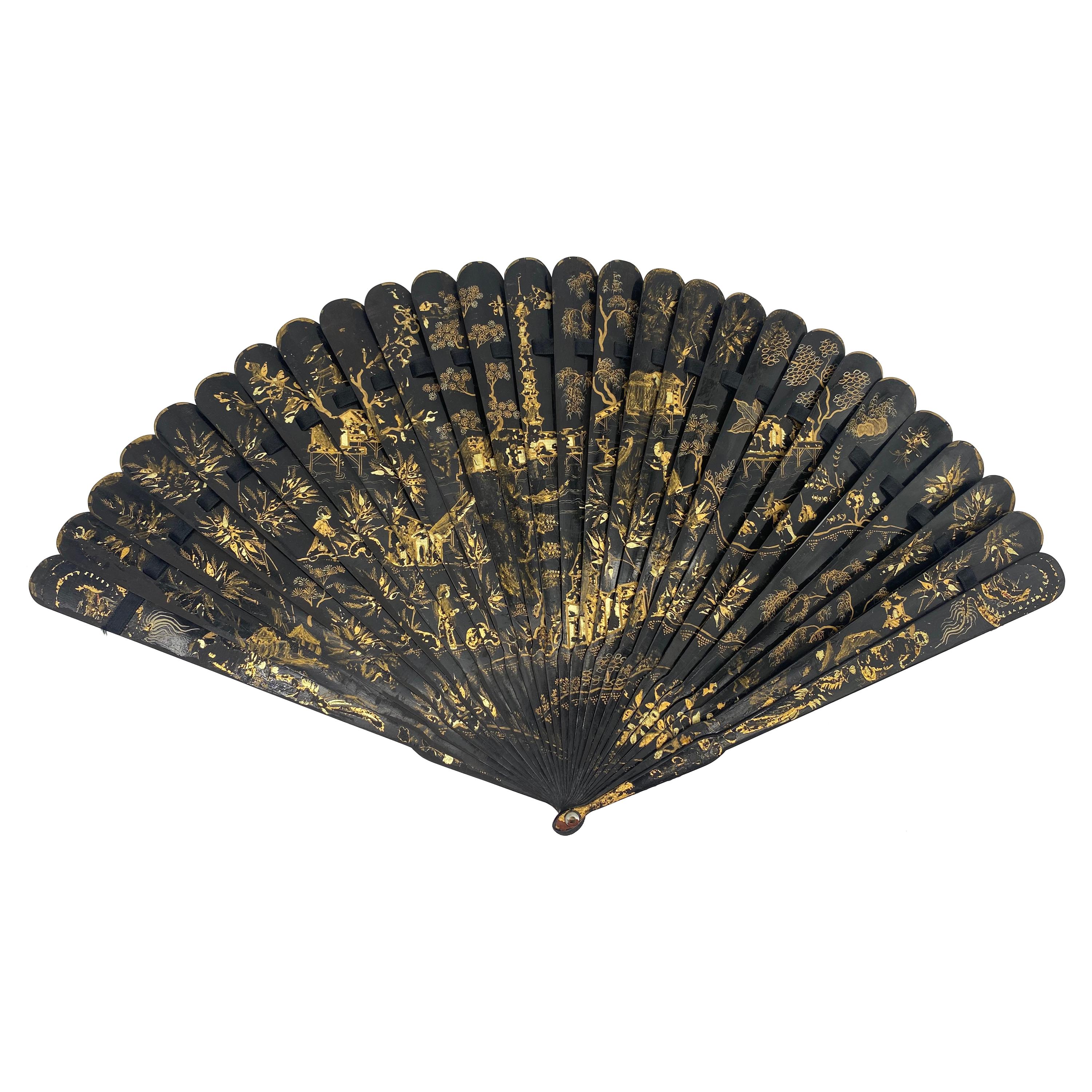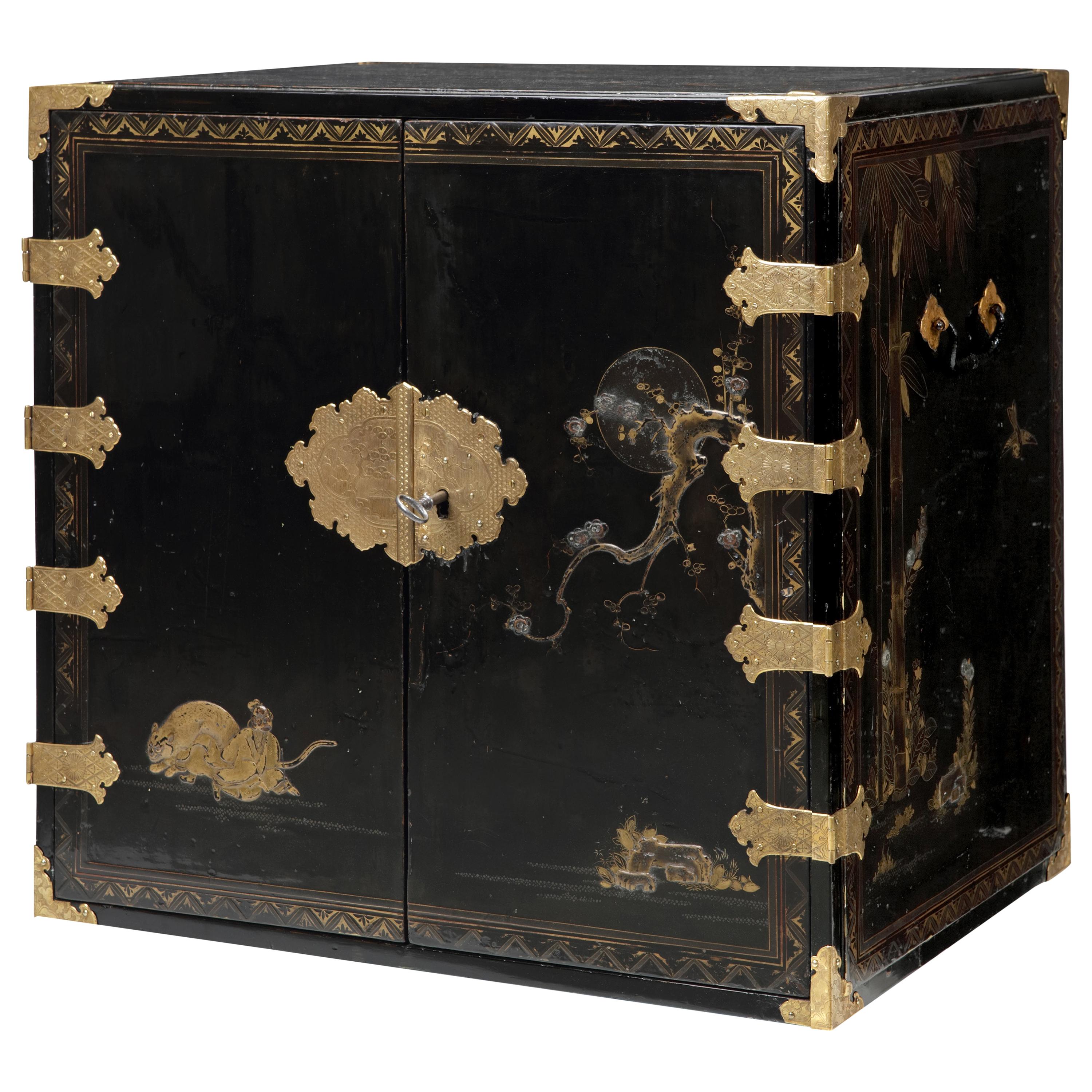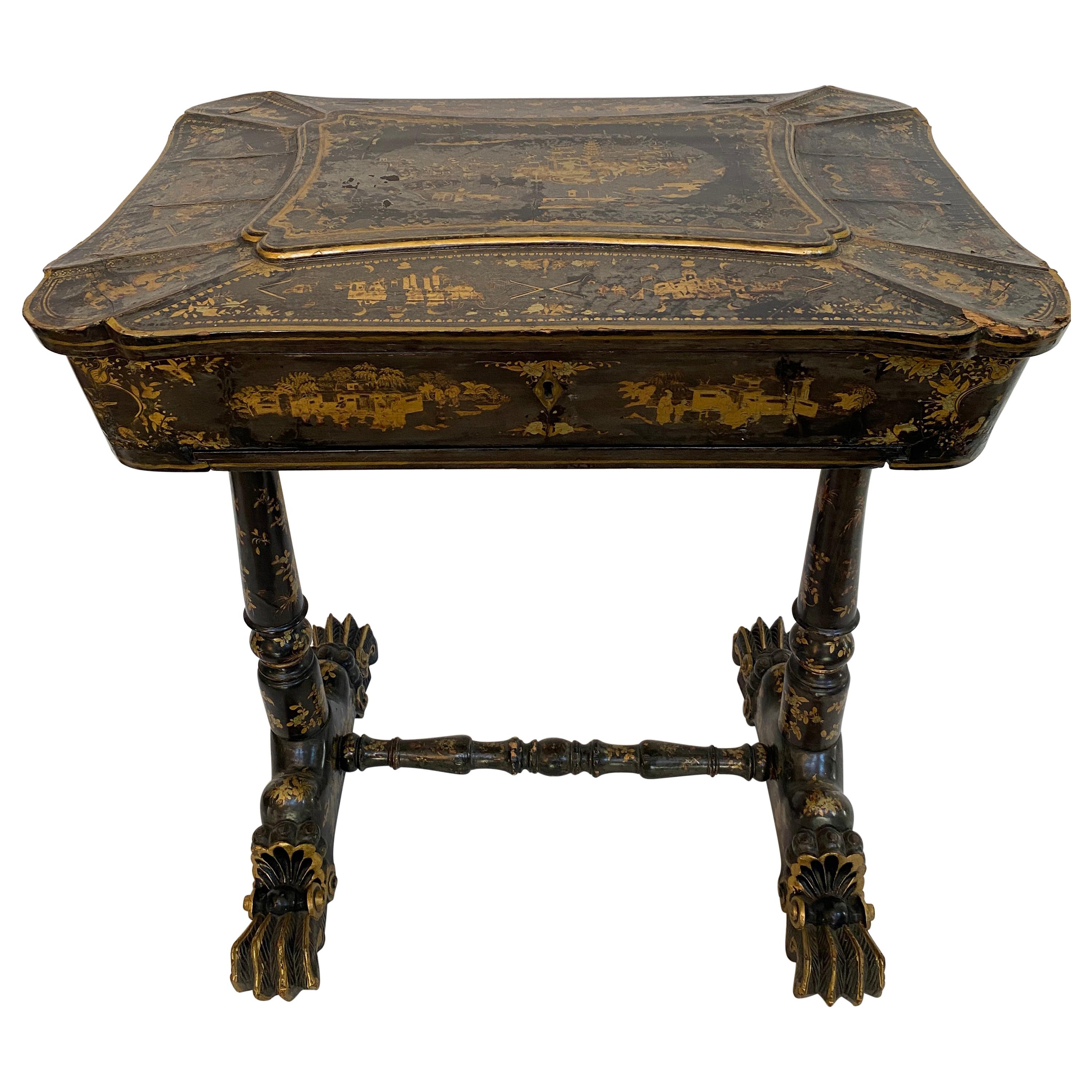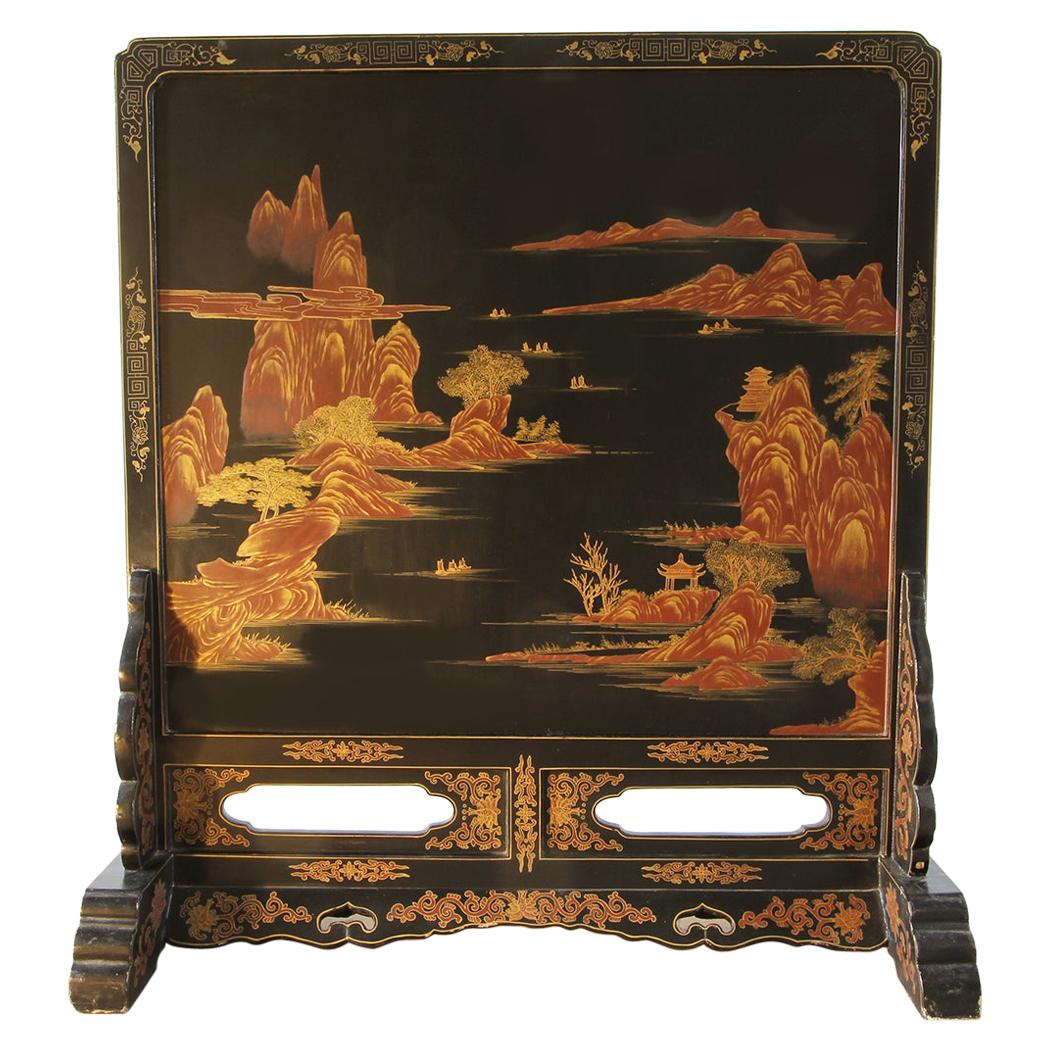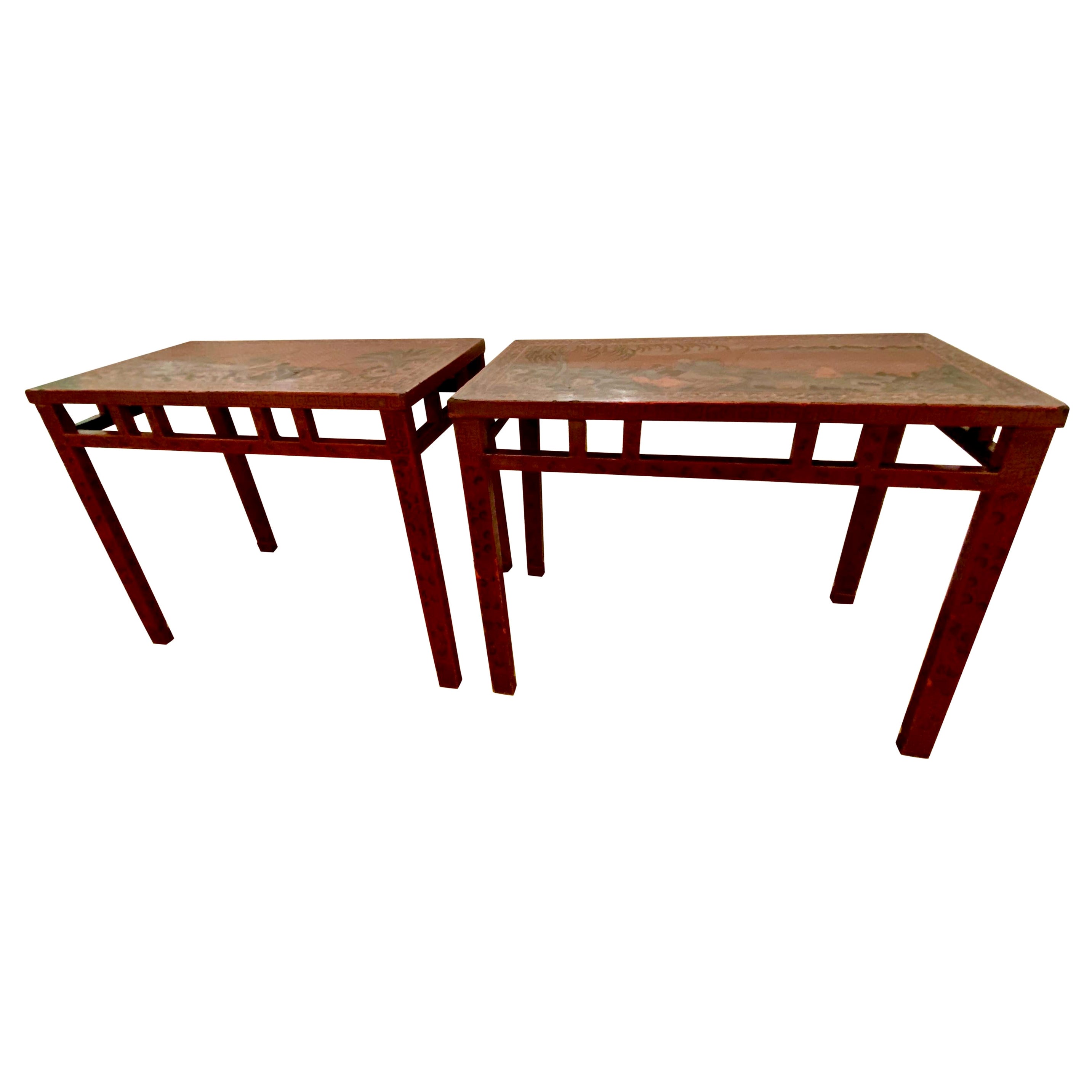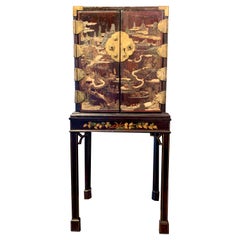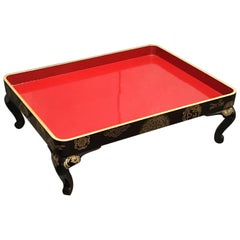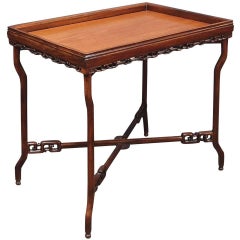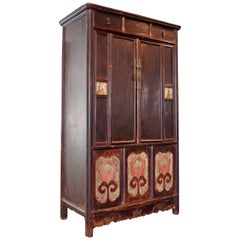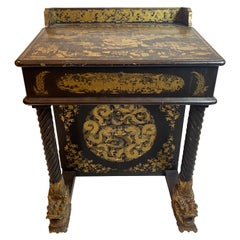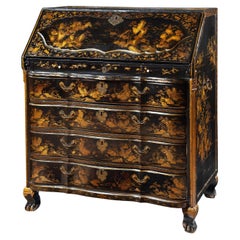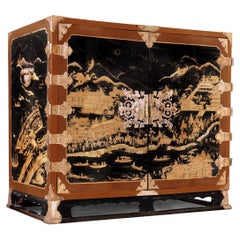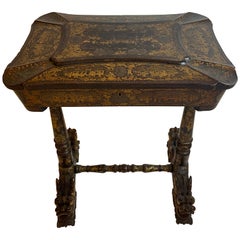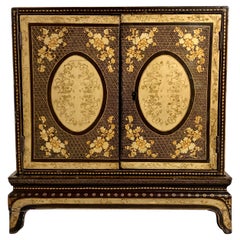
Chinese Export Black Lacquer and Gilt Painted Small Cabinet, Mid 19th Century
View Similar Items
Want more images or videos?
Request additional images or videos from the seller
1 of 17
Chinese Export Black Lacquer and Gilt Painted Small Cabinet, Mid 19th Century
About the Item
- Dimensions:Height: 13 in (33.02 cm)Width: 13 in (33.02 cm)Depth: 8.5 in (21.59 cm)
- Style:Chinese Export (Of the Period)
- Materials and Techniques:
- Place of Origin:
- Period:
- Date of Manufacture:Early to Mid-19th Century
- Condition:Repaired: Repairs to three of the feet of the stand. Additions or alterations made to the original: The lock and lock plate removed. Wear consistent with age and use. Minor losses. Minor structural damages. Minor fading. With minor loss to the lacquer around the edges, as seen in photos. The lock removed, with associated loss to the lacquer. Some cracking to the corners of the door panels. Some minor cracking to the interior of some drawers. Some wear to the painting.
- Seller Location:Austin, TX
- Reference Number:1stDibs: LU894723944912
About the Seller
5.0
Gold Seller
Premium sellers maintaining a 4.3+ rating and 24-hour response times
Established in 2001
1stDibs seller since 2010
340 sales on 1stDibs
Typical response time: 1 hour
Authenticity Guarantee
In the unlikely event there’s an issue with an item’s authenticity, contact us within 1 year for a full refund. DetailsMoney-Back Guarantee
If your item is not as described, is damaged in transit, or does not arrive, contact us within 7 days for a full refund. Details24-Hour Cancellation
You have a 24-hour grace period in which to reconsider your purchase, with no questions asked.Vetted Professional Sellers
Our world-class sellers must adhere to strict standards for service and quality, maintaining the integrity of our listings.Price-Match Guarantee
If you find that a seller listed the same item for a lower price elsewhere, we’ll match it.Trusted Global Delivery
Our best-in-class carrier network provides specialized shipping options worldwide, including custom delivery.More From This Seller
View AllChinese Export Coromandel Lacquer Cabinet on Stand, Mid-19th Century, China
Located in Austin, TX
A delightful Chinese coromandel brown lacquer cabinet on stand, made for the export market, early to mid-19th century, China, presented on an early 20th century custom fitted stand.
The gem of a cabinet is fitted with doors and drawers, and decorated on all sides.
The top, back and sides with lacquer painted scenes of birds and flowers.
The front of the cabinet featuring a pair of stunning coromandel doors carved with a shanshui (mountain and water) landscape scene, complete with temples and pagodas, boats and bridges, and figures, all set against craggy mountains shrouded in clouds and rippling water.
The cabinet mounted with brass hinges and lock plates (key included) and a pair of carrying handles.
Opening the doors reveals eleven wondrous black lacquer drawers...
Category
Antique Mid-19th Century Chinese Chinese Export Furniture
Materials
Brass
Japanese Red and Black Lacquer Maki-e Decorated Presentation Tray, dated 1917
Located in Austin, TX
A fine Japanese red and black maki-e lacquer presentation tray with original tomobako storage box, Taisho period, dated 1917, Japan.
The large prese...
Category
Vintage 1910s Japanese Taisho Lacquer
Materials
Gold
19th Century Chinese Export Hardwood Folding Tray Table
Located in Austin, TX
An elegant Chinese export hardwood tray table set on delicate yoke shaped legs and a hinged x-form stretcher decorated with stylized kui dragons. The he...
Category
Antique 19th Century Chinese Chinese Export Tray Tables
Materials
Hardwood
Chinese Lacquer and Painted Cabinet with Dreamstone Insets, Qing Dynasty, 19th c
Located in Austin, TX
A demure and elegant Chinese tall lacquer cabinet with painted flower panels and dream stone insets, Qing Dynasty, early 19th century, Gansu Province, China.
The tall cabinet of ele...
Category
Antique Early 1800s Chinese Qing Furniture
Materials
Stone, Marble
Small Japanese Lacquer Duck Incense Box, Kogo, Meiji Period, Late 19th Century
Located in Austin, TX
An exquisite Japanese Meiji Period small lacquer incense box, kogo, in the form of a duck or goose, late 19th century, Japan.
The delicate lacquer box, known as a kogo in Japanese, ...
Category
Antique Late 19th Century Japanese Meiji Lacquer
Materials
Lacquer
Japanese Lacquer Incense Burner, Koro, Edo period, mid 19th century, Japan
Located in Austin, TX
An elegant and refined Japanese lacquer koro, incense burner, in the form of a chaire, tea caddy, Edo Perio, mid 19th century, Japan.
The barrel shaped koro formed as a traditional ...
Category
Antique Mid-19th Century Japanese Edo Lacquer
Materials
Copper
You May Also Like
19th Century Chinese Export Lacquer and Gilt Davenport Desk
Located in Brea, CA
Early 19th century Chinese export lacquer and gilt Davenport desk, the entire finely decorated with the typical figural landscape and foliate gilt decoration, the sloped top opening ...
Category
Antique Early 19th Century Chinese Qing Lacquer
Materials
Lacquer
18th Century Chinese Export Lacquer Chinoiserie Bureau Desk for the Dutch Market
Located in Amsterdam, NL
An extremely rare, possibly unique, Chinese export lacquer bureau for the Dutch market
Canton, circa 1737
H. 118 x W. 102.5 x D. 63 cm
Provenance:
- Private collection, The Netherlands
- J.K. Driessen Antiques, Arnhem (Art Fair Breda, 1989)
- Noble collection, Belgium
Literature:
- C.J.A. Jörg, ’De handel van de V.O.C. in Oosters lakwerk in de 18de eeuw’ in: Nederlands Kunsthistorisch Jaarboek , Jr. 31 (1980), pp. 355-363 (ill.)
- Annigje Hofstede, Nederlandse meubelen van Barok tot Biedermeier, 1700-1830, Waanders, Zwolle 2004, pp. 35-37 (ill.)
This lacquer bureau is one of the four writing desks purchased in Canton in 1737, and as far as is known, this is the only remaining bureau of its type from the period. As the VOC believed that large pieces of import took up too much valuable space in their trading ships...
Category
Antique Mid-18th Century Chinese Chinese Export Lacquer
Materials
Wood, Cypress, Lacquer
$87,362
Free Shipping
17th Century Japanese Export Lacquer Cabinet with Depiction the Dutch Tradepost
Located in Amsterdam, NL
A highly important Japanese export lacquer cabinet with depiction of the Dutch East India Company tradepost Deshima and the annual Dutch delegation on its way to the Shogun in Edo
Edo period, circa 1660-1680
H. 88 x W. 100.5 x D. 54 cm
This cabinet includes a later European japanned stand, but also a modern powder-coated steel frame.
The latter can be designed and added to your specific needs.
The sides and front of the rectangular two-door cabinet are embellished in gold and silver hiramaki-e and takamaki-e on a black roiro lacquer ground with a continuous design. The two doors depict a long procession of numerous figures travelling on foot and horseback along buildings and a pagoda into a mountainous landscape. This is the annual court journey, Hofreis, of the Dutch from Nagasaki to the Shogun’s court in Edo. Three horseback riders are dressed as Dutch merchants and a fourth figure, probably het Opperhoofd, is seen inside a palanquin, norimon. Just about to cross the bridge, two men are carrying a cabinet like the present one.
Many Japanese figures on either side of the procession are engaged in various activities; some play musical instruments on board of small boats, others are fishing; figures inside buildings are depicted playing go, and farmers are tending to their rice paddocks. The upper part of the right door shows a large mansion, probably the local daimyo’s castle, with men kneeling before a man in the central courtyard.
The court journey fits in with the foreign policy of the shogunate which accorded a role to the VOC alongside China, Korea, and the Ryukyu Islands who also had to pay tribute. However, the VOC employees were traders, having low status in Japan’s social hierarchy, and they were received with less deference than were the state embassies from Korea and the Ryukyu Islands. Nevertheless, the contacts with the Dutch were a welcome source of information to the Shogun about Europe and European science and technology.
The left side of the cabinet depicts, in mirror image, a rare view of the artificial fan-shaped Deshima Island, the trading post for the Dutch in Japan. The island, where the Dutch flag flies, is surrounded by small Japanese boats and an anchored three-masted fluyt (cargo ship), flying Dutch flags, with on the stern the VOC monogram. On the bottom right a busy street of Nagasaki is shown, bordered by shops and leading up to the stone bridge. On the island the trees are beautifully painted, two cows can be seen, and the flagpole, all in very fine detail. Dutchmen and enslaved Malay are visible outside the buildings and two Japanese figures, probably guards, sit in a small hut in the centre.
A maximum of fifteen to twenty Dutchmen lived on the island at any time and soldiers or women were not allowed. Restrictions on Deshima were tight, and the merchants were only allowed to leave the island by special permission. The Opperhoofd had to be replaced every year, and each new Opperhoofd had to make a court journey to pay tribute, present gifts, and to obtain permission to Margaret Barclay eep on trading. In the distance, many birds fly above the hills and a four-story pagoda can be seen. The right side of the cabinet is painted with other horse riders and their retinue journeying through mountains.
The pair of doors to the front open to reveal ten rectangular drawers. The drawers are decorated with scenes of birds in flight and landscapes with trees and plants. The reverse of the left door with two thatched buildings, one with a ladder, underneath a camelia tree with large blooms; the right door with a three-story pagoda nestled among trees and both doors with a flying phoenix, ho-oo bird. The cabinet, with elaborately engraved gilt copper mounts, hinges, lock plates and brass handles, is raised on an 18th-century English japanned wood stand.
A pair of large cabinets...
Category
Antique 17th Century Japanese Edo Lacquer
Materials
Copper, Gold
$1,456,037
Free Shipping
Early 19th Century Chinese Export Lacquer and Gilt Work Table
Located in Brea, CA
Early 19th century Chinese export lacquer and gilt work table from the Qing Dynasty, with carved gilt dragon head feet, with the table of canted rectangular form, with moulded top, t...
Category
Antique Early 19th Century Chinese Qing Lacquer
Materials
Lacquer
Unique 19th Century Export Chinese Gilt Chinoiserie Lacquer Box
Located in Brea, CA
Unique 19th century export Chinese gilt chinoiserie lacquer box with hand painted scenes gilt export black lacquer, this box has a unique shape, it is f...
Category
Antique Mid-19th Century Chinese Qing Lacquer
Materials
Lacquer
19th Century Chinese Export Table Top Black Lacquer Jewelry/Valuables Cabinet
Located in Incline Village, NV
Chinoiserie hand painted 19th century Chinese export jewelry cabinet circa 1880; is fronted by a pair of raised panel double doors; decorated in gilt with scenes of Chinese figures, ...
Category
Antique 1880s Chinese Qing Lacquer
Materials
Wood
Recently Viewed
View AllMore Ways To Browse
Chinese Export Cabinet On Stand
Chinese Export Black Lacquer Gilt
Meiji Lacquer Box
Japanese Mother Of Pearl Art
Chinese Carved Cinnabar
Japanese Lacquerware
Antique Chinese Cinnabar
Japanese Black Lacquer Tray
Antique Japanese Lacquer Tray
Vintage Lacquer
Japanese Pearl Inlay
Japanese Document Boxes
Asian Cinnabar
Asian Black Lacquer Pearl Furniture
Black Cinnabar
Japanese Urushi
Red Lacquer Cinnabar
Large Japanese Lacquer Box
